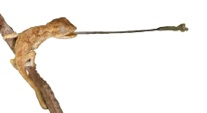Chameleon Care &
Information Center (CCIC)
Chameleon Care &
Information Center (CCIC)




Old world chameleons of the family Chamaeleonidae are generally ascribed to continental Africa and Madagascar. This family inhabits the majority of this area with the exception of some of the most inhospitable regions of the Sahara. They are also known from many of the islands in the area including the Comoros, Mauritius, Reunion and the Seychelles. The common or European chameleon, Chamaeleo chamaeleon, is also known to occur in Southern Portugal and Spain, Greece, Crete, Cyprus, Malta, Sicily, Turkey, Israel, Jordan, Lebanon and Syria among other regions. Chameleons are also known to inhabit the southern Arabian Peninsula and along the Western coast of India and Pakistan and the island of Sri Lanka. Trioceros jacksonii xantholophus is known to have established feral populations in Hawaii, California and Florida and Chamaeleo calyptratus has been known to have feral populations in Hawaii and possibly Florida.
The genera Brookesia, Calumma and Furcifer are restricted to the island of Madagascar and some surrounding islands. These are the only chameleon species from the island which contains the largest diversity within the family. The genus Bradypodion are small South African ovoviviparous species. The genus Kinyongia are oviparous species from Eastern Africa which vary greatly in size and ornamentation. The genus Nadzikambia is a monotypic genus restricted to a single Mountain in Malawi. Members of the genera Rhampholeon and Rieppeleon species are present in central Africa ranging from Cameroon to Northern Somalia and as far South as Mozambique. The genus Chamaeleo covers the majority of continental Africa even reaching Southern Europe, the Middle East and West India and Sri Lanka. The genus Trioceros inhabits central Africa from Sudan and Ethiopia south to Mozambique.
Chameleons are known to inhabit a wide range of environments. The Namaqua Chameleon, Chamaeleo namaquensis lives in the coastal desert of Namibia and South Africa while species like the Peacock Chameleon, Trioceros wiedersheimi, live in cool, humid rainforest habitats. Due to this extreme diversity in habitat choice, it is very important to understand the natural history of chameleons in order to begin to understand their husbandry and reproductive needs.
References:
Necas, P. 2004. Chameleons: Nature's Hidden Jewels, 2nd revised and expanded edition. Zoo Book Sales, Lanesboro, MN.
Range
Copyright © 1998-2014 Christopher V. Anderson. All Rights Reserved.
Reproduction in whole or part is expressly forbidden without written permission.
For permission, please contact Christopher V. Anderson at cvanders@mail.usf.edu